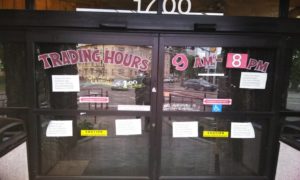Issued late night on June 30, Seattle Mayor Jenny Durkan’s executive order authorized all city departments to reply to “exigent life safety, public health, and property issues” in and around protestors’ CHOP (Capitol Hill Organized Protest) zone.
Protestors established the zone on June 8, following nightly demonstrations that busied the 11th and Pine intersection with chants for justice and repeated deployment of chemical irritants and rubber bullets upon hundreds of peaceful protestors.
Effective July 1 at 2:00 a.m., Durkan’s mandate to shut down the area to restore public operations comes after claims from SPD and residents that crime is increasing at an alarming rate due to the protestors’ occupation of the space. Shootings around the area in the past weeks, which have caused the death of two teens, have been cited by both Durkan and SPD Chief Carmen Best as a threat to public safety.
“The CHOP has become lawless and brutal,” said Best in a statement following Durkan’s executive order, though several of the four shootings recorded occurred outside (though near) the CHOP boundaries.
The reported offenses “in” CHOP from June 8-30, compiled by SPD from the NIBRS (National Incident-Based Reporting System), include 3 blocks where there are no official CHOP demonstrators/operations established.
“It’s time for people to go home,” announced Durkan at a press conference on June 22, where she and Best formally announced efforts would be made to dissolve the CHOP area.
Durkan’s executive order authorized the Seattle Police Department to enforce the closure and provided dispersal orders, specifying that those in defiance would be subject to arrest. It also included that use of force should follow SPD policy and the terms of the Preliminary Injunction issued by Black Lives Matter v. City of Seattle. This is following demands from the Black Lives Matter Seattle-King County joined by the ACLU, Seattle City Council, and protestors to outlaw use of chemical weapons against peaceful protestors.
In Black Lives Matter v. City of Seattle, Judge Richard Jones issued a temporary restraining order prohibiting the use of chemical irritants or projectiles against any peacefully engaged protestor, including pepper spray. The temporary restraining order was set to expire June 26. However, Judge Jones extended it until September 30, 2020.
Though the order protects officers’ right to employ chemical irritants based on “necessary, reasonable, proportional, and targeted action to protect against a specific imminent threat of physical harm”, documentation shows that in at least one instance during the dispersal process, pepper spray was employed on peaceful protestors being forced out of the area in the early morning hours of July 1.
The Seattle Police Department Manual details procedures for crowd management, indicating within 14.090-TSK-3, that when issuing a dispersal order, a reasonable amount of time is provisioned for the crowd to disperse. Protestors and press disputed this, as the dispersal orders were being spoken while police moved into the space, hindering the ability of occupants to vacate the area.
SPD announced a dispersal order at 4:58 a.m., but by 5:30 a.m. made over 25 arrests for failure to disperse, assault, and obstruction.
Occupants awoke urgently to collect their personal items, housing, and navigate police forces, receiving little time to disperse effectively. Many protestors claim that pepper spray was employed into occupied tents in front of the East Precinct, being awoken to alleged unlawful use of chemical irritants.
Since the dissemination of CHOP, and during ongoing demonstrations surrounding the boundaries of the now police occupied area, over 60 arrests have been made.
Washington Secretary of Health John Wiesman has issued a statewide mandatory face covering order effective since June 26. During the altercations within the area, protestors gathered at intersections surrounding the CHOP area being dissolved, facing police lines where many officers were seen without a mask.
Many protestors confronted police officers who were violating this order and are thus subject to criminal penalties, reiterating a common motif heard since the protests began over a month ago that police officers are not above the law.
Since the dismantling of CHOP, protestors have gathered at the Broadway and Pine intersection, including notable leaders from demonstrations in the area this past month, such as a man who goes by Malcolm, and Rick Hearns.
Around the 6:00 p.m. hour on July 1, Malcolm, who can be often identified carrying a megaphone, was reportedly assaulted by an individual in the crowd, calling on the police line in front of him to make an arrest and open an investigation.
However, officers made no arrest and allegedly lied about opening an investigation, according to Malcolm.
The crowd, which gathered between 50-100 protestors throughout the day, saw the police line retreat as the day progressed, approaching the crowd as they saw fit from a minimum distance of about 20-30 feet away, rather than facing protestors from a close distance.
With tensions high, July 1 saw momentary division within demonstrators at Broadway and Pine, arguments arising in regard to speakers ‘policing’ the crowd, remaining peaceful with language, and 1st amendment rights to use vulgar language against officers.
The crowd also saw several individuals try to agitate police officers by attempting to take off the police ‘do not cross’ tape line, or crossing it, but protestors acted quickly to hold these individuals back.
During one of these agitations, a man crossed the police line and several police officers approached from their position about half a block away. Police approached slowly, allowing time for the crowd to deescalate the agitator. One of the officer’s first actions was to pull out his taser, some grabbed their batons as they approached.
By the time police were face-to-face with the crowd, the individual was already pulled away by the crowd.
However this seemed to be an isolated instance as police officers did not maintain this approach that night when they rushed into the crowd violently, employing pepper spray and making several arrests at Broadway and Pine. A recording of the incident shows no aggravation from demonstrators before the police line advanced at approximately 12:30 a.m.
Many continued to protest at intersections surrounding the area now occupied by police. Later, police officers deployed what was suspected to be a “blast ball” with a chemical irritant in the same location.
Though the “Black Lives Matter” mural painted along Pine St, leading up to the 11th and Pine intersection was preserved by the city, officials began power washing all art and graffiti that painted the streets for weeks on July 2- these powerful phrases and artworks had become a creative outlet for protestors in the past month.
Around 5:30 p.m., the police also saw an unexplained use of force and several arrests according to recordings from several angles, due to a suspect who was allegedly trying to pass the police tape.
Documentation shows this individual was even with the tape boundary, and arrests were made of peaceful demonstrators implicated in the conflict. One of the individuals arrested was restrained on the ground with a police officer’s knee to his neck. No police officers disrupted the controversial arrest tactic.
That night, protestors occupied the entire Broadway and Pine intersection, disrupting traffic. Initially, the crowd allowed buses and hospital runs to bypass, but due to disputes over this in the crowd, leaders agreed to block all transportation from continuing through the intersection. Some cited that it was essential for the movement to cause absolute disruption, without exception.
With an organized small group of less than 50, bikes and cars were directed to preserve blockades, while some warned intoxicated individuals to leave the area after several were spotted disrupting the demonstration.
“Y’all are fine driving up and down the streets,” says a speaker leading chants and directing the group, “but I am scared to walk up and down the streets sometimes.”
She says the demonstration is essential, detailing how black people endure so much racism, and that the few hours they spend demonstrating is nothing for these police officers to endure in comparison. She wants people to listen, learn, be open-minded, and visit these demonstrations.
“CHOP made us lose some momentum,” she adds, “but we’re just going to come back and shut the city down. If they’re not gonna listen to us in one area, they’re going to listen to us in multiple.”









Comments are closed.